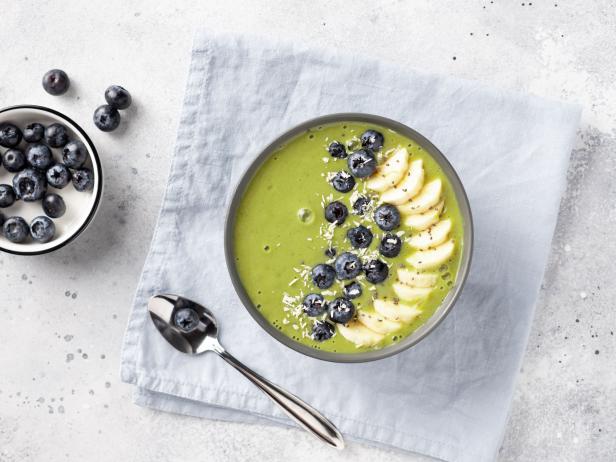Is the South Beach Diet Healthy?
This two-phase diet promises to help you lose weight fast and has a loyal celebrity following. But is it actually a healthy way to lose weight?

Mila Naumova/Getty
Once the high-protein craze began to die down, the South Beach Diet swooped in and promised weight loss without cutting the carbs. In 2021, this diet ranked number 20 out of 39 of U.S. News & World Report’s best overall diets. But what is the South Beach Diet and does it work?
What Is the South Beach Diet?
In the early 2000s, folks began to realize that it was unhealthy to eliminate carbs from your diet (like Atkins suggested), and the South Beach Diet became popular. Rather than cut a whole food group, this diet promises you can lose that belly fat by eating “good carbs” (from whole grains, fruits and veggies) and “good fats” (from lean meats, olive and canola oil).
Food that are dubbed "bad carbs" (and off limits) include white bread, sugar and baked goods. The “bad fats” are butter, high-fat cheeses and red meat. In 2008, the South Beach folks released an updated version of the diet in the book The South Beach Diet Super Charged, which promotes a quicker rate of weight loss by adding more intense exercise to the plan to complement each phase.
The South Beach Diet is divided into two phases and now includes a home delivery program (though it’s still in being revamped and unavailable at this time).
Body Reboot: This precedes phase 1 and lasts one week. The meal plan includes three meals and three snacks daily. Most days include South Beach Diet prepared meals and two snacks (a bar and a shake). Twice a week you cook your own meal or dine out. Some additional grocery store items do need to be purchased to complete this meal plan.
Phase 1: You follow this phase until you reach your desired weight. This can take two weeks or six months. The goal is to lose about a pound per week and to limit daily net carbs to 50 grams (g net carbs = g total carbs minus g fiber). Foods included in this phase are high quality proteins like fish, chicken, turkey, shellfish, lean beef and soy along with nonstarchy vegetables. Small amounts of beans, peas, and lentils and very small amounts of high fiber fruit like strawberries and high protein whole grains like quinoa are permitted.
Phase 2: The phase is designed so you can live the “South Beach lifestyle” for the long term. You can eat a broader range of foods, but if they lead to weight gain, they go back on the forbidden food list. This phase begins by reintroducing more “good carbs,” like whole grains, lower sugar fruits and starchy vegetables. Net carbs also becomes less strict increasing to 75 to 100 grams per day. At least 25% of your daily calories should come from protein.
South Beach also launched the Keto-Friendly South Beach diet, which is similar to a keto plan that is low in carbs and high in fat but is not as strict as the keto diet in limiting carbs and doesn’t require you staying in ketosis to lose weight.
Exercise is not the focal point of this the original plan, but at least 30 minutes of activity are encouraged daily during the weight loss phase and 60 minutes each day during weight maintenance.
How Much Does It Cost?
Along with a customized meal plan, the South Beach Diet website offers free information about the South Beach DIY diet including nutrition, lifestyle and fitness, plus free recipes.
In 2017, Nutrisystem acquired the South Beach brand, and South Beach is supposedly undergoing some revamping to their meal plans. Amazon and other grocery store chains no longer offer South Beach branded foods at this time. You can also purchase a variety of books on the South Beach diet recipes and even their keto plan.
Benefits of the South Beach Diet
- No calorie counting or measuring portions.
- Encourages lean proteins, whole grains and healthy fats.
- Phase 2 is reasonable and pretty well balanced (though I’m not a fan of restricting any types of fruits and veggies).
Cons of the South Beach Diet
- The Reboot Phase and Phase 1 restricts most fruits, vegetables and whole grains and is too low in calories.
- Eating out is difficult, especially in the beginning.
- Time management is required to plan, shop and cook your meals.
- Not advisable for people with certain medical conditions including those who are pregnant, allergic to soy or peanuts, have an eating disorder, of kidney condition.
Bottom Line: This plan is rather restrictive at the beginning, but Phase 2 the eating plan is more well-balanced with enough calories for most people.
Toby Amidor, MS, RD, CDN, is a registered dietitian and consultant who specializes in food safety and culinary nutrition. She is the author of The Greek Yogurt Kitchen: More Than 130 Delicious, Healthy Recipes for Every Meal of the Day.
*This article was written and/or reviewed by an independent registered dietitian nutritionist.
Related Links:


































